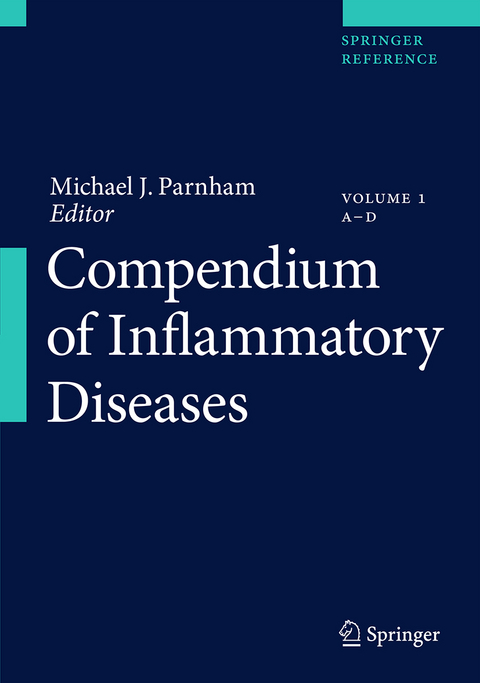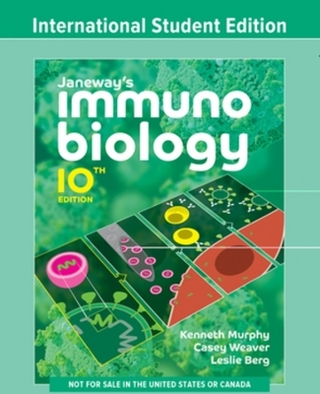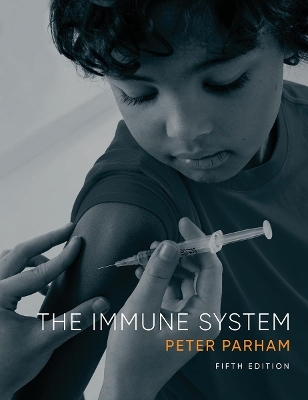
Compendium of Inflammatory Diseases
Springer Basel
978-3-7643-8530-9 (ISBN)
Inflammation has become one of the most exciting and rewarding areas of medical research. Recent years have seen a revolution in our understanding of how blood and tissue cells interact and of the intracellular mechanisms controlling their activation. This has revealed the underlying inflammatory pathology of many diseases and provided multiple new targets for anti-inflammatory and immunomodulatory therapy. The Compendium of Inflammatory Diseases covers the following areas:
- Inflammatory Processes and Cells
- Inflammatory Diseases
- Mediators of Inflammation
- Pharmacology of Inflammation
Since inflammatory diseases and their therapy cover a broad range of scientific and medical fields, the encyclopedia will be co-edited by four international experts, a clinician and three researchers from the disciplines of immunology, biochemistry, and pharmacology, in this way providing students, basic and clinical scientists and practitioners in academia, hospitals and industry with valuable interlinked information.
This living project will serve as a reliable and comprehensive data pool for everybody working in inflammation research. Owing to its dynamic nature, it will grow with time and future editions, becoming an indispensible source of information for academia, clinical practitioners and industry.Michael Parnham studied pharmacology at London University, UK and obtained his PhD in pharmacology at Bristol University, subsequently performing postdoctoral work in inflammation at Erasmus University Rotterdam, The Netherlands. He is currently Head of Preclinical Research in the Fraunhofer Institute of Molecular Biology & Applied Ecology, Project Group for Translational Medicine & Pharmacology TMP, Frankfurt am Main, Germany and since 1998 has been Adjunct Professor of Pharmacology & Toxicology at Goethe University Frankfurt. He is also a Fellow of the British Pharmacological Society. Prior to his present position, Dr Parnham was Visiting Scientist in the Hospital for Infectious Diseases Zagreb, Croatia and Director of Preclinical Discovery, GlaxoSmithKline, Zagreb. From 1998 to 2006 he was Head of Pharmacology & Toxicology and then Senior Scientific Advisor at PLIVA, Zagreb and was previously employed for a decade by A. Nattermann and subsequently Rhône-Poulenc Santé in Cologne, Germany, where he rose to become Head of General Biology. Dr Parnham has researched and published extensively on inflammatory mediators and mechanisms, anti-inflammatory, antibiotic and immunomodulatory drugs, toxicology and the pharmacology of selenium. He was Managing Editor of the international journal Inflammation Research from 1992 to 2013 and is editor of several book series, including Milestones in Drug Therapy and Progress in Inflammation Research, and the textbook Principles of Immunopharmacology. He has helped discover and develop 6 compounds up to clinical trials, including 2 novel biologicals and a seleno-organic compound, for which he and his group received the Prix Galien Germany in 1990. Dr Parnham has run a pharmaco-toxicological consultancy in Germany for 8 years, has been involved in discussions with EMEA on drug safety and was a representative of the European Generics Association on the working group for biosimilar drugs. In 2015, he received the Lifetime Achievement Award of the International Association of Inflammation Societies.
Adhesion molecules of neutrophils.- Anaphylaxis (Immediate hypersensitivity): from old to new mechanisms.- Antiviral Responses.- Autophagy and Inflammation.- Basophils.- Cell signalling in neutrophils.- Co-stimulatory Receptors.- Dendritic Cells.- GILZ-Related Regulation of Inflammation.- Glial Cells.- Immunoglobulin receptors and inflammation.-Inflammation and autoimmunity.- Inflammatory Bowel Disease Models in Animals.- Leukocyte Recruitment.- Lymphocyte homing and trafficking.- Macrophage heterogeneity during inflammation.- Mast Cells.- Mechanisms of Macrophage Migration in 3-Dimensional Environments.- Microvascular Responses to Inflammation.- Modulation of inflammation by key nutrials.- Natural Killer Cells.- Neutrophil Extracellular Traps.- Neutrophil oxidative burst.- Obesity and Inflammation.- Osteoclasts in Inflammation.- Parasitism: A Unique Lifestyle Reflecting Dynamic Parasite- and Host(s)-Co-driven Processes.- Platelet, Endothelium, and Inflammation.- Regulatory Tcells.- Sepsis Models in Animals.- Skin inflammation models in animals.- Th17 Response.- Toll-Like Receptors.- Angiogenesis Inhibitors.- Anti-asthma Drugs, Overview.- Anti-histamines.- Anti-muscarinics.- Antibiotics as anti-inflammatory drugs.- Antimalarial Drugs.- Azathioprine/Thiopurines.- Beta2 Agonists.- CD 20 Inhibitors - Rituximab.- CD80/86 Inhibitors.- Chromones - Cromoglycate and Nedocromil.- Colony stimulating factor therapeutics.- Corticosteroids.- Coxibs.- Disease-Modifying Anti-Rheumatic Drugs.- Fenamates.- Flavonoids as anti-inflammatory agents.- Gold Complexes.- Interleukin 1 Inhibitors.- Interleukin 12/23 Inhibitors: Ustekinumab Interleukin-6 Inhibitor - Tocilizumab.- Leflunomide.- Medicinal Fatty Acids.- Methotrexate.-NO-donating anti-inflammatory drugs.- Non-steroidal anti-inflammatory drugs.- Phosphodiesterase-4 inhibitors.- Propionic Acid Derivative Drugs (Profens).- Salicylates.- Sulfasalazine and Related Drugs.- Tetracyclines.- Theophylline.- TNF Inhibitors.- Acute exacerbations of airway inflammation.- Allergic Disorders.- Alzheimer's Disease.- Antiphospholipid antibody syndrome.- Asthma.- Atopic dermatitis.- Autoinflammatory syndromes.- Behcet's disease.- Bronchiolitis obliterans.- Cancer and inflammation.- Cogan's syndrome.- COPD.- Diabetes type I.- Diabetes type II.- Diffuse panbronchiolitis.- Gaucher's disease.- Genetic susceptibility to inflammatory diseases.- Gout.- Graft vs Host Disease.- Granulomatosis with Polyangiitis (GPA).- Grave's disease.-Guillaine-Barre disease.- Henoch-Schönlein Purpura.- Idiopathic Thrombocytopenic Purpura.- Inflammatory bowel disease.- Juvenile idiopathic arthritis.- Kawasaki Disease.- Lyme disease.- Osteoarthritis.-Osteoarthritis Genetics.- Polymyositis and Dermatomyositis.- Rheumatic Fever.- Rheumatoid arthritis.- Role of Cell Therapy in Autoimmune Disease.- Sarcoidosis.- Sepsis.- Spondylarthropathies.- ACKR3.- Adhesion molecules.- Alarmins.- Antibacterial Host .-Defense Peptides.- Bacterial Lipopolysaccharide.-Biofilm.- Bone Morphogenetic Proteins in Inflammation.- C5a Receptors.- CCL18.- CCR1.- Ceramide 1-Phosphate: A Mediator of Inflammatory Responses.- Complement System.- CXCL4 und CXCL4L1.- CXCR1 and CXCR2 and Ligands.- CXCR3 and its Ligands.- Cytokines.- Cytolytic Granules.- Foxp3.- Heat Shock Proteins.- Histamine.- IFNgamma.- IkappaB.- Inflammasomes.- Interleukin 1.- Interleukin 10.- Interleukin 12.- Interleukin 17.- Interleukin 18.- Interleukin 18 Binding Protein.- Interleukin 2.- Interleukin 22.- Interleukin 23.- Interleukin 27.- Interleukin 32.- Interleukin 36 Cytokines.- Interleukin 4 and the related cytokines (Interleukin 5 and Interleukin 13).- Interleukin 6.- Interleukin 9.- Interleukin-33.- Janus Kinases (JAKs)/STAT Pathway.- Kinins.- Leukotrienes.- Mammalian Target of Rapamycin (mTOR).- MAP Kinase Pathways.- NFkappaB.- Nitric oxide.- Nuclear Receptor Signaling in the Control of Inflammation.- Pathogen-Associated Molecular Patterns (PAMPs).- Pentraxins.- Prostanoids.- Protease-Activated Receptors.- Reactive oxygen species.- Substance P in Inflammation.- TGF-b superfamily cytokine MIC-1/GDF15 in health and inflammatory diseases.- TNFalpha.- Type I Interferons.
| Erscheint lt. Verlag | 6.10.2016 |
|---|---|
| Mitarbeit |
Chef-Herausgeber: Michael J. Parnham |
| Zusatzinfo | XXXI, 1301 p. 218 illus., 147 illus. in color. In 2 volumes, not available separately. |
| Verlagsort | Basel |
| Sprache | englisch |
| Maße | 178 x 254 mm |
| Themenwelt | Studium ► Querschnittsbereiche ► Infektiologie / Immunologie |
| Schlagworte | biochemistry • Biomedical and Life Sciences • Cell Biology • immunology • Infectious Diseases • Inflammatory Diseases • Inflammatory Processes and Cells • Mediators of Inflammation • Organ-related Inflammatory Diseases • Pharmacology of Inflammation • Pharmacology/Toxicology • rheumatology • Systemic Inflammatory Diseases |
| ISBN-10 | 3-7643-8530-8 / 3764385308 |
| ISBN-13 | 978-3-7643-8530-9 / 9783764385309 |
| Zustand | Neuware |
| Haben Sie eine Frage zum Produkt? |
aus dem Bereich


